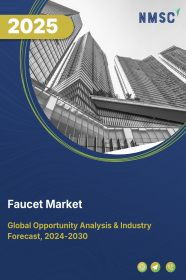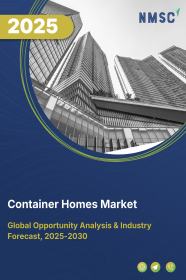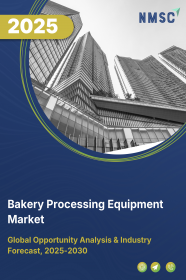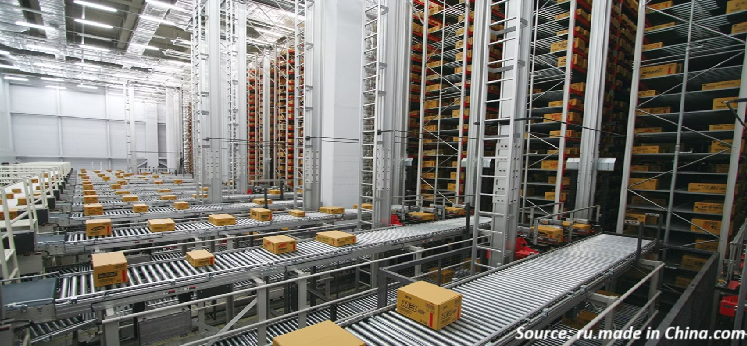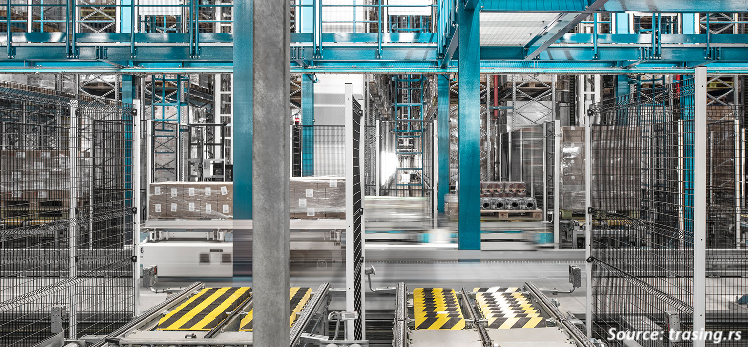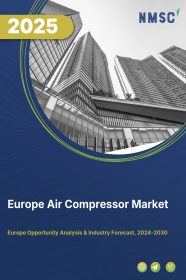
Europe Air Compressor Market by Type (Portable and Stationary), by Technology (Rotary Screw, Centrifugal, and Reciprocating), by Lubrication Type (Oil-Free and Oil-Injected/Flooded), by Power Rating (0-100 Kw, 101-300 Kw, 301-500 Kw, and 501 Kw & Above), by Cooling Method (Air Cooled and Water Cooled), and by Industry Vertical (Manufacturing, Construction, Oil & Gas, Healthcare, and Others) – Opportunity Analysis and Industry Forecast, 2024– 2030
Industry: Construction & Manufacturing | Publish Date: 01-Feb-2025 | No of Pages: 359 | No. of Tables: 284 | No. of Figures: 229 | Format: PDF | Report Code : CM2163
US Tariff Impact on Europe Air Compressor Market
Trump Tariffs Are Reshaping Global Business
Europe Air Compressor Market Overview
The Europe Air Compressor Market size was valued at USD 4.77 billion in 2023, and is projected to reach USD 6.78 billion by 2030, at a CAGR of 4.7% from 2024 to 2030. In terms of volume, the market size was 154 thousand units in 2023, and is projected to reach 273 thousand units by 2030, with a CAGR of 8.0% from 2024 to 2030. An air compressor is an essential mechanical device used across various industries to generate compressed air, that is vital for many applications.
It primarily converts power from sources such as electric motors or diesel engines into potential energy stored as compressed air. This pressurized air is then used to power pneumatic tools and equipment, inflate tires, supply air to HVAC systems for climate control, and support industrial processes such as spray painting and packaging. Essentially, an air compressor provides a reliable source of compressed air, crucial for a wide range of tasks and operations in diverse business and industrial environments.
Construction and Pharmaceutical Sectors Drives the Europe Air Compressor Market Demand
In Europe, the demand for air compressors is being driven by various industries and factors across the continent. The construction industry needs pneumatic tools such as nail guns and jackhammers which boosts the growth of Europe air compressor market growth.
While the substantial investment in the R&D sector of pharmaceutical sector of the region is accelerating the demand for air compressor market for maintaining sterile conditions and ensuring efficient pharmaceutical production. According to the European Federation of Pharmaceutical Association report 2023, in 2021 the pharmaceutical industry invested more than USD 46,962.5 million in R&D in Europe.
Growing Manufacturing, Maritime, and Agriculture Industries Creates Demand for Europe Air Compressor Industry
The presence of strong manufacturing sector is another factor behind the growing demand for air compressor as this industry relies on compressed air systems for various production processes. According to the European Commission report 2024, the manufacturing sector of Europe contributed to one quarter of EU’s business economy net turnover, with USD 8.51 trillion, an increase of 16 % compared to 2020.
While the maritime industry relies on compressors for ship operations, propelling the Europe air compressor market demand in the region. Moreover, On 25 July 2023, the EU officially concluded the legislative process to strengthen the Energy Efficiency Directive.
This target sets the goal of reducing EU final energy consumption by 11.7% by 2030, compared to the projected energy use for 2030. It indicates about the presence of strict regulations towards energy efficiency adopted in the region that drives the adoption of energy efficient air compressor to lower carbon footprint and reduce environmental impact.
The rising growth of the agriculture industry in the region is propelling the demand for air compressors for tasks such as operating pneumatic seeders, sprayers, and irrigation systems, enhancing efficiency and precision in farming practices. According to the European Commission report 2024, The EU's agricultural industry created an estimated gross value added of USD 235.4 billion that contributed to around 1.4 % to the EU's GDP in 2022.
Similarly, there is an adoption of air compressors in the sectors such as, mining, oil & gas, and food processing within the Europe air compressor market due to the growing infrastructure development, and increasing industrialization. According to International Energy Agency report, European share of oil supply in the total oil supply accounts for 21% that is 24,732,630 terajoule (TJ) that indicates of an increase in global share by 14% in 2021.
High Initial and Maintenance Costs Hinders the Growth of the Europe Air Compressor Market
The initial cost involved with air compressors, alongside the requirement for regular maintenance such as filter changes, lubrication, and inspections, contributes to the total cost of ownership.
This financial constraint acts as a restraining factor in the Europe air compressor market growth. Consequently, small and medium-sized businesses hesitate to invest in new air compressor systems or upgrade existing ones, potentially slowing down the industry growth.
The Integration of IoT Sensors and Cloud Platforms is Expected to Create Ample Growth Opportunities for the Market
The incorporation of IoT sensors and cloud platforms into air compressors is poised to unlock future growth opportunities within the Europe air compressor market. This integration facilitates remote monitoring, predictive maintenance, and performance optimization of compressors. IoT sensors, embedded within air compressors, continuously gather real-time data on critical parameters such as temperature, pressure, and energy consumption.
Subsequently, this data is transmitted to cloud platforms where advanced analytics algorithms analyse it to identify potential issues, forecast maintenance requirements, and enhance compressor operations. Through harnessing IoT and cloud technologies, organizations can minimize downtime, improve equipment reliability, and optimize energy usage, thereby fueling demand for intelligent air compressor solutions and stimulating market expansion.
Germany Dominates the Europe Air Compressor Market Share
The presence of stringent regulation in Germany with increasing governmental expenditure in support of energy efficiency programs accelerates the adoption of air compressor as businesses strive to reduce both operational costs and their environmental footprint. Modern air compressor systems equipped with advanced energy-saving features, such as variable speed drives and efficient motors, are highly sought after for their ability to optimize energy usage.
For instance, the Germany government adopted National Action Plan on Energy Efficiency (NAPE) under the EU Energy Efficiency Directive for implementation of strategy for enhancing energy efficiency in the country, covering energy saving for buildings, companies, transportation, and regular consumers.
The strategy allocated an annual funding of USD 1.2271 billion to a number of energy efficiency programs with a target to reduce energy consumption by 60% by 2050. The presence of regulatory support towards energy efficiency indicates about a prospective growth opportunity for adoption of efficient air compressors in the country.
Moreover, the significant growth of the food industry in the country is further driving the Europe air compressor market growth. Food industry is dependent on the use of air compressors for packaging, sorting, and conveying food products, enhancing efficiency and productivity.
According to the United States Department of Agriculture report 2024, German food processing industry generated a turnover of approximately USD 239 billion that represents around 5.8% of the national GDP. The prospective growth of the country’s chemical industry propels the demand for air compressor to maintain high-quality production standards in the food processing units.
Denmark to Witness Substantial Growth in the Europe Air Compressor Market
Denmark is one of the largest producers of oil and gas in the region that accelerates the Europe air compressor market demand. In oil refining, air compressors are essential for processes such as catalytic cracking, hydrocracking, and hydrotreating, where precise and reliable compressed air is necessary.
According to International Energy Agency report 2022, Denmark ranks as 19th largest country in Europe in terms of oil refining those accounts for 3,50,001 terajoule (TJ) and produce 44% of domestic crude oil that is around 1,36,948 terajoule (TJ). Thus, it reflects about a positive outlook for the growth of efficient and high-performance air compressor systems.
Moreover, the adoption of strict regulations towards energy efficiency is another major catalyst behind the growth of the Europe air compressor market. For instance, 2050 Energy Strategy was adopted by Danish Government in 2019 to attain 100% independence from fossil fuel in the national energy mix by 2050. It indicates about the need for companies to increasingly prioritize sustainability in their operations that necessities the adoption of energy efficient air compressors to contribute towards energy savings and lower the environmental impact.
Competitive Landscape
The market players operating in the Europe air compressor industry include Ingersoll Rand Inc., Atlas Copco Group, Siemens AG, Mitsubishi Heavy Industries Ltd., Kaeser Kompressoren, Anest Iwata Corporation, MATTEI GROUP, CompAir, Boge Compressoren, BAUER COMP Holding GmbH, Emerson Electric Co., ALMiG Kompressoren GmbH, FNA S.p.A., Danfoss A/S, Hitachi Ltd., and others.
Europe Air Compressor Market Key Segments
By Type
-
Portable
-
Stationary
By Technology
-
Rotary Screw
-
Centrifugal
-
Reciprocating
By Lubrication Type
-
Oil-Free
-
Oil-Injected/Flooded
By Power Rating
-
0-100 kW
-
101-300 kW
-
301-500 kW
-
501 kW & Above
By Cooling Method
-
Air Cooled
-
Water Cooled
By Industry Vertical
-
Manufacturing
-
Construction
-
Oil & Gas
-
Healthcare
-
Others
By Country
-
UK
-
Germany
-
France
-
Italy
-
Spain
-
Denmark
-
Netherlands
-
Finland
-
Sweden
-
Norway
-
Russia
-
Rest of Europe
KEY PLAYERS
-
Ingersoll Rand Inc.
-
Atlas Copco Group
-
Siemens AG
-
Mitsubishi Heavy Industries Ltd.
-
Kaeser Kompressoren
-
Anest Iwata Corporation
-
MATTEI GROUP
-
CompAir
-
Boge Compressoren
-
BAUER COMP Holding GmbH
-
Emerson Electric Co.
-
ALMiG Kompressoren GmbH
-
FNA S.p.A.
-
Danfoss A/S
-
Hitachi Ltd.
REPORT SCOPE AND SEGMENTATION:
|
Parameters |
Details |
|
Market Size in 2023 |
USD 4.77 Billion |
|
Revenue Forecast in 2030 |
USD 6.78 Billion |
|
Growth Rate |
CAGR of 4.7% from 2024 to 2030 |
|
Market Volume in 2023 |
154 thousand units |
|
Unit Forecast in 2030 |
273 thousand units |
|
Volume Growth Rate |
CAGR of 8.0% from 2024 to 2030 |
|
Analysis Period |
2023–2030 |
|
Base Year Considered |
2023 |
|
Forecast Period |
2024–2030 |
|
Market Size Estimation |
Billion (USD) |
|
Growth Factors |
|
|
Countries Covered |
15 |
|
Companies Profiled |
10 |
|
Market Share |
Available for 10 companies |
|
Customization Scope |
Free customization (equivalent up to 80 working hours of analysts) after purchase. Addition or alteration to country, regional, and segment scope. |
|
Pricing and Purchase Options |
Avail customized purchase options to meet your exact research needs. |

















 Speak to Our Analyst
Speak to Our Analyst



